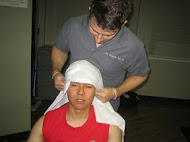Typically head injuries result from road carnages, diving in unknown shallow water levels, falling down facing your head to the ground and many others. There are various indicators that a person’s head has been injured. Among them are: headache, vision impairment, being numb, unresponsiveness, bruises around the eyes, paralysis, blood running to the white of the eye and many others. The aforementioned causes may lead to fracturing of the skull or worse still lead to brain injury.
Before taking any action, assess the possibility of a spinal cord injury. In case you find that the casualty is responsive, you should keep them still and give them assurance. Remain keen to note any change of the crucial signs and call the paramedics for assistance. On the other hand, if you find that the patient is unresponsive, then do a primary survey and remain cautious because the casualty may be suffering from a spinal injury. Signs of the spinal injury include: alteration of sensation, bumps of the neck or back which could be irregular, the patient experiences discomfort at the back area or neck and slow pulse.
When the patient is responsive in the case of spinal injury all you need to do is to assure the casualty and ensure that there is minimal movement of the both the spinal column and head. Keep monitoring the victim’s signs and note any changes; make sure that the body temperature is kept normal.
In a situation where the patient is unresponsive, give support to the casualty’s head and neck as you keep watch on the crucial signs and avoid twisting and forward movement of the neck. You can support the neck by placing heavy towels on each side. While doing this make sure you don’t interfere with the person’s breathing system.
Give first aid to the patient as need will be while keeping the patient’s neck or head still. Where there are no circulation signs such as coughing and breathing, start CPR but ensure that the head is untitled. Next open the airway of the victim by gently grasping the jaw and lifting it up using your fingers. If you realize that the patient does not have pulse then start chest compressions.
In a situation where the patient has the helmet on, do not attempt removing it. If the patient is choking on blood or vomiting and you must move him/her so as to avoid further injury then you must look for help from at least one person. Let one person be at the side of the patient and the other at the head. Now work together keeping the casualty’s head, back and neck aligned as you roll the person to one side. Next, call for assistance from a doctor.
